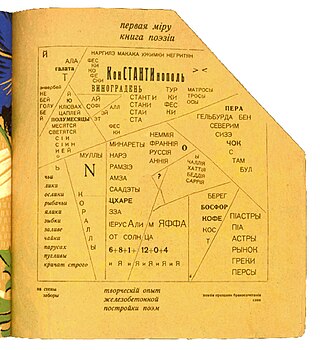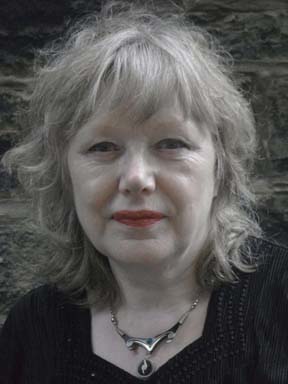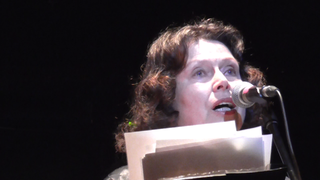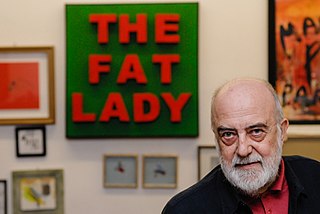Related Research Articles

Concrete poetry is an arrangement of linguistic elements in which the typographical effect is more important in conveying meaning than verbal significance. It is sometimes referred to as visual poetry, a term that has now developed a distinct meaning of its own. Concrete poetry relates more to the visual than to the verbal arts although there is a considerable overlap in the kind of product to which it refers. Historically, however, concrete poetry has developed from a long tradition of shaped or patterned poems in which the words are arranged in such a way as to depict their subject.

Performance poetry is a broad term, encompassing a variety of styles and genres. In brief, it is poetry that is specifically composed for or during a performance before an audience. During the 1980s, the term came into popular usage to describe poetry written or composed for performance rather than print distribution, mostly open to improvisation.

Dame Edith Louisa Sitwell was a British poet and critic and the eldest of the three literary Sitwells. She reacted badly to her eccentric, unloving parents and lived much of her life with her governess. She never married but became passionately attached to Russian painter Pavel Tchelitchew, and her home was always open to London's poetic circle, to whom she was generous and helpful.
Peter Finch is a Welsh author, psychogeographer and poet living in Cardiff, Wales.
"The British Poetry Revival" is the general name given to a loose poetry movement in Britain that took place in the 1960s and 1970s. The revival was a modernist-inspired reaction to the Movement's more conservative approach to British poetry. The poets included an older generation - Bob Cobbing, Paula Claire, Tom Raworth, Eric Mottram, Jeff Nuttall, Andrew Crozier, Lee Harwood, Allen Fisher, Iain Sinclair—and a younger generation: Paul Buck, Bill Griffiths, John Hall, John James, Gilbert Adair, Lawrence Upton, Peter Finch, Ulli Freer, Ken Edwards, Robert Gavin Hampson, Gavin Selerie, Frances Presley, Elaine Randell, Robert Sheppard Paul Evans Adrian Clarke, Clive Fencott, Maggie O'Sullivan, Cris Cheek, Tony Lopez and Denise Riley.

Brian William Bransom Griffiths, known as Bill Griffiths, was a poet and Anglo-Saxon scholar associated with the British Poetry Revival.
Bob Cobbing was a British sound, visual, concrete and performance poet who was a central figure in the British Poetry Revival.
Eric Mottram was a British teacher, critic, editor and poet who was one of the central figures in the British Poetry Revival.
Sound poetry is an artistic form bridging literacy and musical composition, in which the phonetic aspects of human speech are foregrounded instead of more conventional semantic and syntactic values; "verse without words". By definition, sound poetry is intended primarily for performance.
Lawrence Upton, was a poet, graphic artist and sound artist, and director of Writers Forum.

Geraldine Monk is a British poet. She was born in Blackburn, Lancashire. Since the late 1970s, she has published many collections of poetry and has recorded her poetry in collaboration with musicians. Monk's poetry has been published in many anthologies, most recently appearing in the Anthology of 20th Century British and Irish Poetry.

Mirella Bentivoglio was an Italian sculptor, poet, performance artist and curator.
Net-poetry is a development of net.art, involving poetry. This kind of experimental art was born in several different cities and countries around 1995.
Adrian Clarke is a contemporary British poet. His collections include Skeleton Sonnets, Former Haunts, Possession: Poems 1996-2006, and Eurochants.

Katalin Ladik is a Hungarian poet, performance artist and actress. She was born in Újvidék, Kingdom of Hungary, and in the last 20 years she has lived and worked alternately in Novi Sad, in Budapest, Hungary and on the island of Hvar, Croatia. Parallel to her written poems she also creates sound poems and visual poems, performance art, writes and performs experimental music and audio plays. She is also a performer and an experimental artist. She explores language through visual and vocal expressions, as well as movement and gestures. Her work includes collages, photography, records, performances and happenings in both urban and natural environments.
Writers Forum is a small publisher, workshop and writers' network established by Bob Cobbing. The roots of Writers Forum were in the 1954 arts organisation Group H, and the And magazine that Cobbing edited. The writers' branch of Group H was called Writers Forum. In 1963 a press with the publishing imprint "Writers Forum" was begun and administered by Cobbing, John Rowan and Jeff Nuttall. Between 1963 and 2002 Writers' Forum published more than one thousand pamphlets and books including works by John Cage, Allen Ginsberg, Brion Gysin, and P. J. O'Rourke, as well as a wide range of British Poetry Revival modernist poets, such as Eric Mottram, Bill Griffiths, Geraldine Monk, Maggie O'Sullivan, Paula Claire and Sean Bonney. While publishing was integral to the Cobbing-led workshop, it also provided an opportunity for poets to read their works in a supportive and non-critical environment.

Ugo Carrega was an Italian artist and poet. Carrega was one of the main exponents of visual poetry, although he preferred the term "New Writing", an experimental form of writing that combines signs of different extraction. Carrega was active mainly in Milan, where he founded the cultural centers Centro Suolo (1969), Centro Tool (1971), Mercato del Sale (1974) and Euforia Costante (1993). He also founded and directed the art magazines Tool (1965), Bollettino Tool (1968), aaa (1969) and Bollettino da dentro (1972).
Alembic was a poetry magazine established by Peter Barry, Ken Edwards, and Robert Gavin Hampson, which appeared eight times during the 1970s. It existed between 1973 and 1978. The magazine was based in London.

Michael Harlow is a poet, publisher, editor and librettist. A recipient of the Katherine Mansfield Menton Fellowship (1986) and the University of Otago Robert Burns Fellowship (2009), he has twice been a poetry finalist in the New Zealand Book Awards. In 2018 he was awarded the Prime Minister's Award for Literary Achievement, alongside playwright Renée and critic and curator Wystan Curnow Harlow has published 12 books of poetry and one book on writing poetry.
Ida Florence Affleck Graves was a British artist, poet, novelist, and children's writer, and member of the Bloomsbury Group.
References
- 1 2 3 "Authors | Archive of the Now". www.archiveofthenow.org. Retrieved 10 January 2018.
- ↑ Bernstein, Charles (30 April 1998). Close Listening: Poetry and the Performed Word. Oxford University Press. ISBN 9780195355079.
- 1 2 Claire, Paula (1968). Mobile poems Greece. England?: P. Claire. ISBN 0900290005. OCLC 22255934.
- ↑ "Paula Claire". Discogs. Retrieved 10 January 2018.
- ↑ "Resoundscore - The Fellowship Of The Green Parrot". Discogs. Retrieved 10 January 2018.
- ↑ Claire, Paula (1978). Codestones of Venice. London: Writers Forum. ISBN 0861622294. OCLC 83081928.
- ↑ Claire, Paula (1974). Stone tones. London: Writers Forum. OCLC 10059169.
- ↑ Blake, Heidi (10 June 2010). "Oxford professor of poetry election mired in controversy again over sexism claims". The Daily Telegraph. ISSN 0307-1235 . Retrieved 11 January 2018.
- ↑ "From Word to Art with PoetArtist Paula Claire".
- ↑ "Tinted Window No 2 - Antenne Books".
- ↑ "News | the Society of Authors".
- ↑ "Paula Claire :: National Association of Writers in Education ::". www.nawe.co.uk. Retrieved 11 January 2018.
- ↑ Claire, Paula; Cobbing, Bob (1972). Soundsword. London: Writers Forum. OCLC 10059139.
- ↑ Claire, Paula; Mottram, Eric (1991). Declarations: poems, 1961-91. London: Arts Council Poetry Library. ISBN 0948953284. OCLC 24893577.
- ↑ Claire, Paula; Bentivoglio, Mirella (2012). Going for gold: [an outline illustrated with poems and photos]. Part one, Part one. Oxford: Paula Claire. ISBN 978-0948953408. OCLC 824509754.